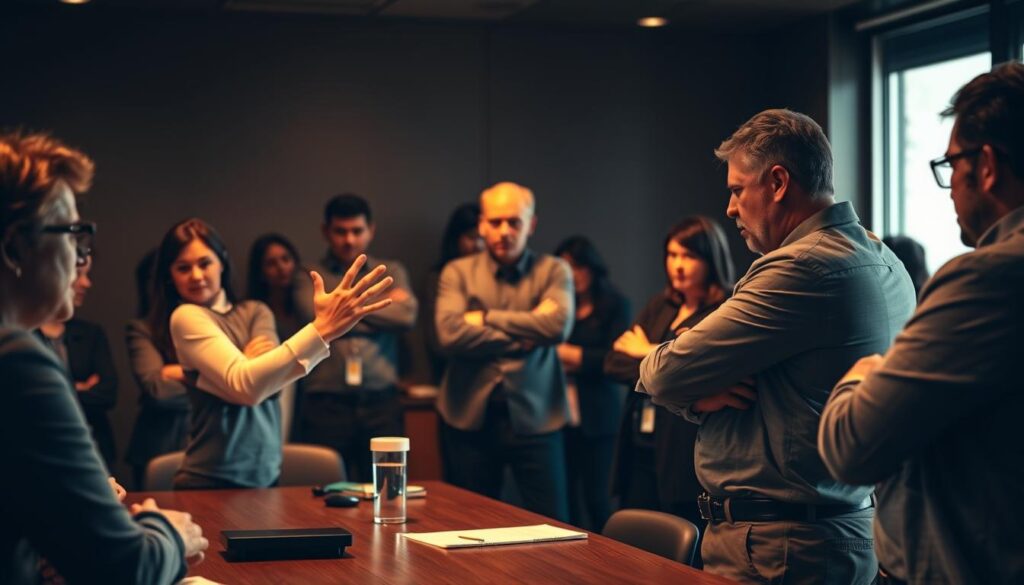As a manager, you know how vital a calm work place is. Good conflict management is key to this. By using the right strategies, you can fix tense situations and create a better work environment.
A manager with conflict skills can change everything. Keeping communication open and listening to your team are important. Also, focus on the issue, not the person. You might want to use workshop ideas to teach leaders how to manage conflicts better.
Table of Contents
Key Takeaways
- Maintain open and clear communication to prevent conflicts.
- Focus on the problem, not the individuals, when resolving conflicts.
- Implement leadership workshops to equip leaders with conflict management tools.
- Improve communication skills through role-playing and feedback workshops.
- Enhance team sense through outdoor activities and trust-building exercises.
Understanding the Nature of Team Conflicts
To solve team conflicts, we must first know their causes and effects. Conflicts happen when team members have different interests, opinions, and beliefs. Recognising these factors is key to resolving conflicts.
Common Causes of Team Conflicts in the Workplace
Poor communication and differing opinions are common causes of team conflicts. Biases and learning style differences also play a part. For example, a study showed that communication style differences often lead to conflicts.
The Impact of Unresolved Conflicts on Team Performance
Unresolved conflicts can harm team unity and performance. They can cause low morale, reduced productivity, and higher turnover. Conflict resolution experts warn that unresolved conflicts can make the work environment toxic, affecting team goals.
“Conflict, when managed properly, can lead to growth and innovation.”
Why Conflict Isn’t Always Negative
Conflicts are not always bad. They can spark discussions, encourage creativity, and improve decision-making. By understanding and managing conflicts well, we can turn negatives into positives. For more on team conflict resolution, check out our blog post.
Recognising Different Types of Team Conflicts
Team conflicts can take many forms, each needing a special way to solve them. Knowing these types is key to managing conflicts well. It helps create a positive team atmosphere.
Task-Based Conflicts: Disagreements About Work
Task-based conflicts happen when team members disagree on work content and outcomes. These issues often come from different opinions or ways of doing tasks.
Examples and Indicators
Signs of task-based conflicts include debates on project goals and disputes over task allocation. For example, team members might argue over resource allocation or task priority.
- Debates over project goals and objectives
- Disputes about task allocation and responsibility
- Disagreements over the best methods to achieve objectives
Relationship Conflicts: Interpersonal Tensions
Relationship conflicts are about personal tensions and often stem from communication issues or different values.
How to Identify Them Early
Early signs of relationship conflicts include increased tension and less communication. Regular team meetings and open communication can spot these issues early.
| Indicator | Description |
|---|---|
| Increased tension | Observable strain among team members |
| Decreased communication | Team members become less forthcoming or withdrawn |
| Signs of distrust | Team members question each other’s motives or integrity |
Process Conflicts: Disputes About Methods
Process conflicts happen when team members disagree on how to do tasks. This includes issues with delegation, resource allocation, and procedures.
For example, disagreements on workflow or task delegation can cause process conflicts.
“The way we work together is just as important as the work we do.”
Value-Based Conflicts: Clashing Principles
Value-based conflicts occur when team members have different values guiding their actions and decisions.
These conflicts are hard because they involve deeply held beliefs. For instance, ethical discussions or different priorities can lead to value-based conflicts.
By understanding and recognising these conflict types, you can create effective strategies. This improves team performance and unity.
Early Warning Signs of Team Conflict
Dealing with team conflicts starts with spotting early signs. Knowing these signs helps you solve problems before they get worse.
Behavioural Indicators to Watch For
Changes in how team members act can show conflicts brewing. Look for signs like being short-tempered, pulling away, or not joining in. For tips on a united team, check our guide on creating a high-performance team.
Communication Breakdowns and Patterns
Good communication is key for a team’s success. Signs of conflict include less talking, more misunderstandings, or avoiding certain subjects. Keeping an eye on these can help you tackle problems early.
Productivity and Morale Impacts
When team morale or productivity drops, it’s a warning sign. Conflicts can distract team members, leading to less work done and lower quality. It’s important to tackle these issues quickly to keep the team positive and productive.
Team Meeting Dynamics
How a team acts in meetings can show if there are conflicts. Look for side chats, not paying attention, or clear disagreements. These signs mean there are tensions that need to be sorted out for better teamwork.
Creating a Conflict-Positive Team Culture
Teams that handle conflicts well tend to reach their goals. They see conflicts as chances to grow, not as barriers to success.
Establishing Psychological Safety in Your Team
Psychological safety is key for a positive team culture. It lets team members share their thoughts freely, without fear. To build this, promote open talk and make sure everyone feels safe to discuss.
Developing Team Norms for Healthy Disagreement
It’s important to set norms for healthy disagreements. This means clear rules for how team members should talk during disagreements. These norms help keep conflicts constructive.
Regular Team Building Activities That Address Conflict
Team-building activities help unite and build trust. They should encourage teamwork and better communication.
Exercises for Building Trust
Trust-building exercises make team members feel closer. This reduces conflict chances. Examples include team outings and trust games.
Activities for Improving Communication
Good communication stops misunderstandings and solves conflicts. Workshops on listening and clear messaging are helpful.
| Activity Type | Description | Benefits |
|---|---|---|
| Trust-Building Exercises | Team outings, trust games | Increased trust, improved collaboration |
| Communication Workshops | Active listening, clear messaging | Reduced misunderstandings, effective conflict resolution |
Using these strategies, you can build a team culture that handles conflicts well. It also promotes teamwork and productivity.
Conflict Resolution Strategies for Teams
Knowing how to handle conflicts is vital for a team’s harmony. The right strategies can help manage disputes and boost teamwork. This leads to better collaboration among team members.
The Collaborative Approach: Finding Win-Win Solutions
The collaborative method aims to please everyone involved. It promotes open talks, listening, and understanding each other. This way, teams can find solutions that benefit everyone.
For more tips on team management, check out strategies for business success. They show how solving conflicts is key to reaching team goals.
Compromise and Negotiation Techniques
Compromise and negotiation are crucial for team conflicts. They help find a middle ground everyone can agree on. Good negotiation means understanding each side’s needs and limits.
When to Use Accommodation or Avoidance
Accommodation and avoidance can work in some cases. Accommodation means giving in, while avoidance means avoiding the conflict. But, use them wisely, as they might not solve problems for good.
Confrontation: Addressing Issues Directly
Confrontation means tackling conflicts head-on. It’s effective if done right.
Steps for Constructive Confrontation
- Prepare by gathering all the facts.
- Stick to the issue, not personal attacks.
- Listen well to the other side.
- Work together to find a solution that works for all.
Using these strategies, teams can handle conflicts better. This keeps the work environment positive. Effective conflict resolution is essential for team success and reaching goals.
Effective Communication Techniques for Resolving Conflicts
Dealing with conflicts in a team needs a careful way of talking. It’s key for team members to share their thoughts clearly. This helps avoid mistakes and builds a team spirit.
Active Listening Skills for Team Members
Listening well is key to solving conflicts. It means really paying attention to what others say. And then responding with thought.
Paraphrasing and Summarising
Paraphrasing and summarising are big parts of listening well. They help make sure you get what the other person means. And they make sure everyone knows the main points.
Non-Verbal Communication Awareness
Body language and how you sound are big in talking. Knowing these can stop misunderstandings. And help you answer better.
Using “I” Statements to Reduce Defensiveness
Using “I” statements is a smart way to share worries without blaming. It makes talks better and less likely to get defensive. For more tips on good business talk, check out Effective Business Communication.
Facilitating Difficult Conversations
Hard talks are sometimes needed to fix conflicts. To make these talks work, stay calm, listen well, and aim for a solution. For more on solving work conflicts, see Strategies for Conflict Resolution.
Virtual Team Conflict Resolution Communication
With more people working from home, solving conflicts online is key. You need to use digital tools like video calls. They help everyone talk face-to-face and clearly.
Using these good talking methods, teams can handle conflicts better. And work together more smoothly and productively.
The Role of Leadership in Team Conflict Resolution
Leaders play a key role in solving team conflicts. Your way of handling conflicts shows your team how to manage disputes. Good leaders don’t just fix problems; they make a space for constructive conflict management.
Mediating Team Disputes Effectively
Mediating disputes means staying neutral and finding the conflict’s root. Leaders create a safe space for everyone to talk openly. This way, they find solutions that meet everyone’s needs.
To mediate well, leaders should:
- Listen actively to all parties
- Identify common goals
- Encourage open communication
Coaching Team Members Through Conflicts
Coaching team members means teaching them to solve problems on their own. Leaders do this by training them in conflict resolution. They also encourage them to think about their own conflict management.
Leading by Example: Modelling Conflict Resolution
Leaders show their team how to handle conflicts. By showing good conflict resolution, they teach their team that it’s important.
“The way to resolve conflicts is not to avoid them, but to face them with courage and empathy.”
When to Intervene vs. When to Let Teams Resolve Issues
Leaders must decide when to step in and when to let teams solve problems. They should intervene if conflicts get too big or hurt team performance. But, letting teams handle small issues helps them grow and learn.
Using the right strategies and methods for managing conflicts, leaders can make their teams work better together.
Implementing Structured Conflict Resolution Processes
Structured conflict resolution processes help teams deal with disagreements better. They improve performance by addressing conflicts in a systematic way. This ensures conflicts are handled efficiently, keeping team productivity and morale high.
The Five-Step Conflict Resolution Model
The five-step model offers a detailed framework for tackling team conflicts. It ensures all conflict aspects are considered and dealt with properly.
Identifying the Problem
The first step is to find the conflict’s root cause. It involves gathering info from all involved to fully understand the issue.
Generating Solutions
After identifying the problem, the team brainstorms solutions. Everyone shares their ideas in these sessions.
Evaluating and Selecting Solutions
The team then evaluates and picks the best solution. They weigh the pros and cons of each option.
Implementing and Following Up
The chosen solution is put into action. The team checks if it works and if the conflict is truly resolved.
Using Third-Party Mediators
At times, a third-party mediator is helpful. They offer an unbiased view and aid in finding a solution. For more on team structures for conflict resolution, check out this resource.
Documentation and Follow-Up Procedures
It’s important to document the conflict resolution process and follow up. This helps track the solution’s success and spot areas for future improvement.
Conclusion: Building Stronger Teams Through Effective Conflict Management
Managing conflicts well is key to building strong teams and boosting productivity. Understanding team conflicts and using the right strategies can create a culture of open talk and teamwork.
Companies like Pixar and Apple show how good conflict management can lead to more innovation and teamwork. By listening well, focusing on problems, and aiming for solutions that benefit everyone, conflicts can be solved in a positive way.
Training your team in conflict management can give them the tools to handle disputes effectively. For more on the benefits of good conflict management, check out Maven’s article on the subject.
Using these strategies can turn conflicts into chances for growth and improvement. This leads to a more united and productive team environment.
FAQ
What are the most common causes of team conflicts in the workplace?
Team conflicts often come from different opinions and communication problems. They also happen when priorities clash. Other reasons include value, personality, and work style differences.
How can I identify the early warning signs of team conflict?
Watch for changes in body language and tone of voice. Also, look at communication issues, productivity drops, and team meeting changes.
What are the different types of team conflicts, and how can I address them?
Conflicts can be about tasks, relationships, processes, or values. Knowing the type helps you choose the right way to solve it. This could be through working together, finding a middle ground, or facing the issue directly.
How can I create a conflict-positive team culture?
Make sure everyone feels safe to speak up. Set clear team rules and do team-building often. This helps conflicts be solved in a good way.
What are some effective conflict resolution strategies for teams?
Good strategies include working together, finding a middle ground, and facing the issue. Choose the best one for the situation and conflict type.
How can I facilitate difficult conversations during conflict resolution?
Use active listening and “I” statements. Ask open questions to keep the conversation going. Make sure the environment is safe and respectful for everyone to share their thoughts.
What is the role of leadership in team conflict resolution?
Leaders help mediate, coach, and show how to solve conflicts. They decide when to step in and when to let the team handle it.
How can I implement a structured conflict resolution process?
Use a five-step model, mediators, and follow-up steps. This ensures conflicts are solved well and quickly.
What are some effective team conflict resolution methods?
Good methods include clear communication, open feedback, and respect. Team-building and training on solving conflicts also help.
How can I handle conflicts within a virtual team?
Virtual conflicts need careful communication and active listening. Use technology to help talk things through. Be ready for the challenges of online communication and adjust your approach.










